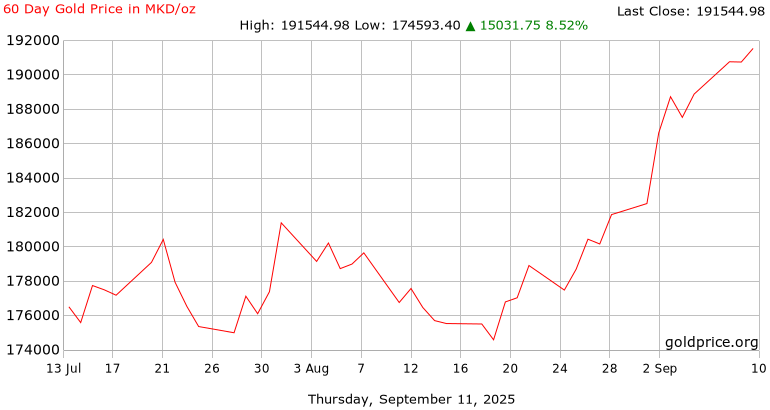Gold Price Macedonia
(Macedonian Denars)
Conversion : 1 troy ounce = 31.1034768 grams
Macedonian Denars 24 Hour Spot Gold and Silver Price
Macedonian Denars Gold Price History Charts
To learn about our gold price data
Gold Price Macedonia
Macedonia is officially known as the Republic of Macedonia. Located in the Balkan Peninsula, the country is a successor state of the former Yugoslavia, from which it became independent in 1991. The nation is bordered by Kosovo, Serbia, Bulgaria, Greece and Albania. The official language of the country is Macedonian, and several other languages are also spoken in the region including Albanian, Turkish, Romani and Serbian. The nation’s government is a parliamentary republic.
The official currency of the country is the Macedonian Denar. The currency was first introduced in 1992, when it replaced the Yugoslav Denar. The currency got its name from the ancient Roman monetary unit, the denarius. The initial denar introduced in 1992 was then replaced the following year by the second denar.
The National Bank of the Republic of Macedonia is the nation’s central bank. The central bank is in charge of issuing and maintaining the republic’s currency. In addition, it also has numerous other responsibilities typical of central banks including maintenance of price stability, regulation of credit, oversight of the banking system and more.
If you are looking to buy gold in Macedonia, you will likely see prices quoted in the local currency. Oftentimes, quotes are also available in numerous other key global currencies such as U.S. Dollars, Japanese Yen, euros or Great British Pounds. Prices are typically quoted by the ounce, gram or kilo.
Gold has been considered a reliable store of wealth and protector of value for thousands of years. Examples of this can be seen in various civilizations and eras. The ancient Philippeioi coin, later called Alexanders, were the gold coins used in the Greek Kingdom of Macedonia. These coins were initially issued at some point between 355 and 347 B.C., and featured a portrait of the Greek deity Apollo on the obverse. The coin’s reverse featured a depiction of a biga, a Greek chariot pulled by two horses. The coin had multiple designs, and was typically used for major purchases outside of the region. This caused the coins to spread, and stashes of the ancient coins have been discovered in numerous locations including Italy, Syria, Cyprus and Egypt.
Gold coins have been valued and used as a medium of exchange for centuries. Although modern day bullion coins are considered good, legal tender, they are not purchased for their monetary value but rather for their metal content. Standard modern day bullion coins can have reasonable premiums over spot, but may still be relatively more expensive per-ounce when compared to gold bars. Collectible or numismatic coins can have significantly higher premiums compared to bullion bars or coins, and may best be avoided by those looking to acquire as much total gold as possible.
Cast bullion bars may provide investors the best overall value. These bars are produced by pouring liquid gold into molds, and then allowing the metal to cool. Because of the way they are made, no two cast bars will look exactly the same. Due to their relatively low fabrication costs, cast bars may offer investors the best overall value on a per-ounce basis.















